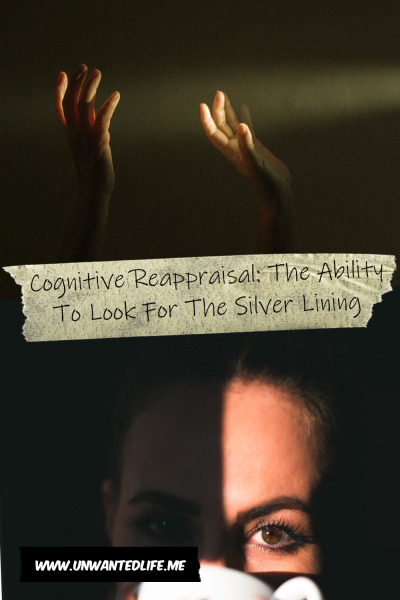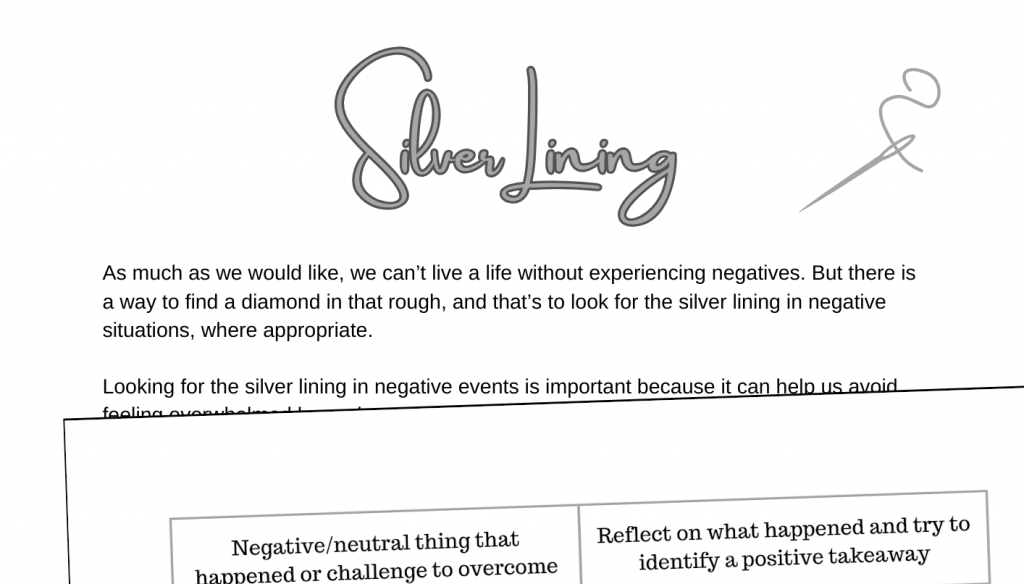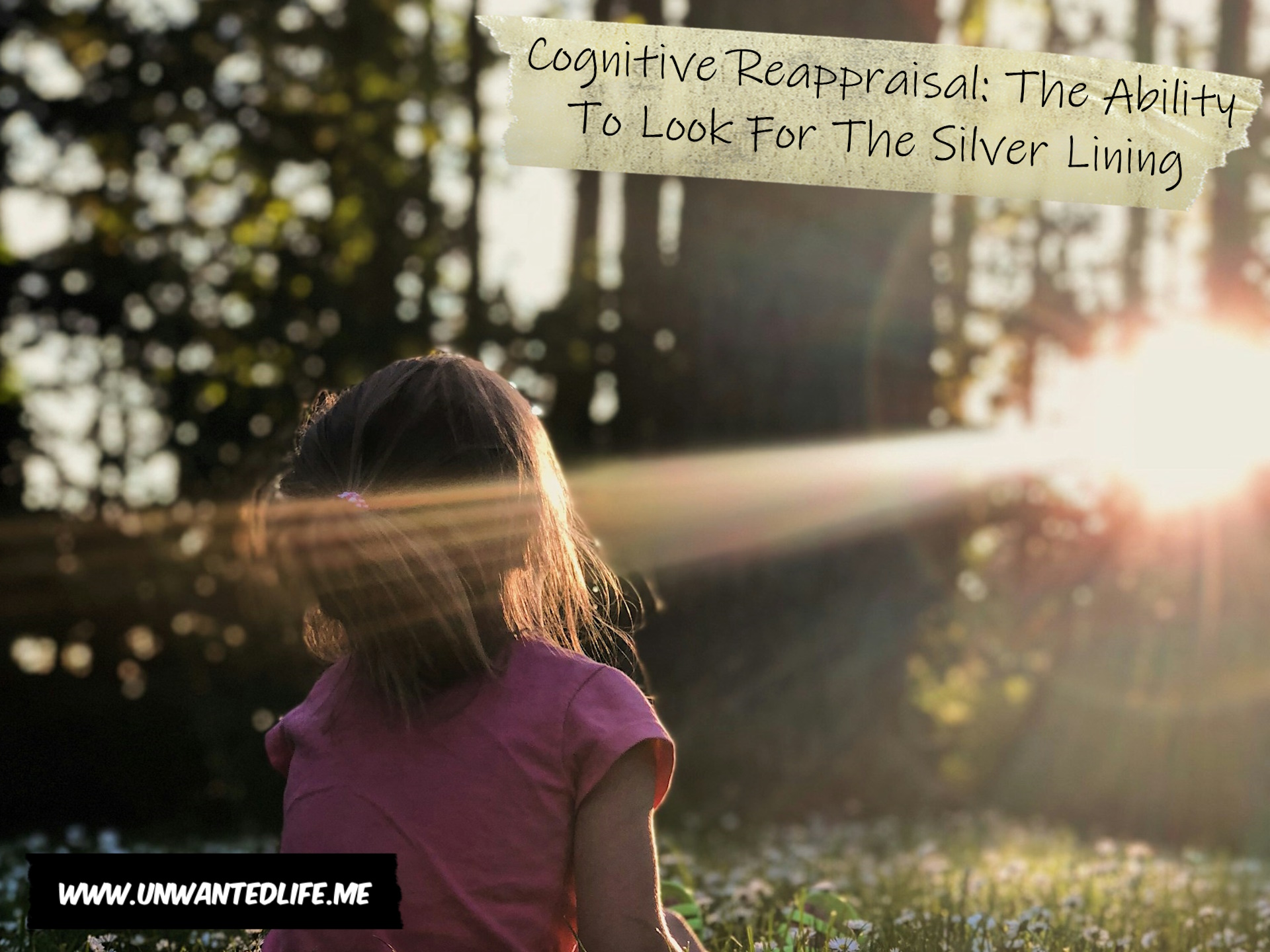For a pretty long time, I always assumed the worst and saw the negative, yet my partner would always find a silver lining. Now, I use thought challenges and look for the silver lining naturally, and I thought this would be a good time to create a worksheet to help others develop this skill as well. A New Year and a new skill to learn.
Disclosure: This article contains links to my Unwanted Life Shop. Read my full disclosure here.
What Is The Definition Of A Silver Lining
According to the Cambridge Dictionary, a silver lining is where there’s an advantage that comes from a difficult or unpleasant situation. But I don’t like this definition. Instead, I prefer the one that Wikipedia offer, which is that a silver lining is a metaphor for optimism where a negative occurrence may have a positive aspect to it. This definition is in keeping with how it’s used in cognitive–behavioural therapy (CBT), as a thinking challenge technique. A skill we can learn to support our mental wellbeing.
What Makes The Looking For A Silver Lining Important?
From a very early age, we will all respond to events differently, whether they’re stressful life events or common everyday events. That is the whole reason why people study individual differences in psychology, which is important to differential psychologists. When it comes to stressful life events, we will be different in how we respond, and this response can also be influenced by impairments like depression (Troy, Wilhelm, Shallcross, and Mauss, 2010).
When depressed, we’re more likely to have developed one or more cognitive biases, such as assuming the worst. So maybe you have struggled to make a GP take your symptoms seriously. Your response might be to think that no one cares, focusing on how hard it was to get someone to take your symptoms seriously.
However, if you focused on how you stuck to guns and were able to get someone to take your symptoms seriously in the end, then how that situation affects you will be quite different. The former reaction is a more common response if you’re already struggling with depression. But the latter finds a positive to focus on, helping to develop a positive mindset.
When looking for a silver lining, we can stop situations from having negative consequences on our mental wellbeing. This is supported by a study by Seery (2011), who also found that the more adverse life events are the worse the outcomes will be. However, they also state that limited exposure to stressors in life presents opportunities to develop resilience. Looking for the silver lining helps develop that resilience.
This happens because such a person can create a bank of experience where they know they can handle such situations, reducing future situations where they may feel overwhelmed. Meaning, that we shouldn’t shelter from stressors, but we also shouldn’t continuously expose ourselves to them either. Burnout is real.
In short, resilience is built by knowing you’re able to get through challenging situations, rather than never having experienced a challenging situation. Taking a silver lining approach is one way to develop this kind of resilience. It’ll turn a negative experience into a neutral/positive-ish one.
Interestingly, the recent COVID-19 pandemic has allowed research to look into how people coped with this historic world event. One such study was conducted by Kowalski, Carroll, and Britt (2022). The study found that those would confronted the adversity that was the COVID-19 pandemic by reappraising the negative occurrence in a positive light (i.e. silver lining) experienced positive outcomes. In short, they turned this horrible world event into an opportunity for post-traumatic growth.
Instead of focusing on the health implications and risks to life that came with the COVID-19 pandemic, they may have focused on the aspects they were grateful for, such as having more time with their family, a slow pace of life, being able to focus on their fitness, or some other form of gratitude.
What Does It Mean To Look For The Silver Lining
Looking for the silver lining, also known as finding the positive in a situation, is a valuable mental habit that can significantly enhance your wellbeing and resilience. It involves actively seeking out the positive aspects of challenging or difficult situations, rather than focusing solely on the negative.

The Benefits Of Looking For The Silver Lining
While acknowledging difficulties is essential, looking for the silver lining helps people maintain a balanced view of situations, fostering a more resilient and positive approach to life’s challenges. Thus, looking for the silver lining refers to seeking the positive or optimistic aspect in challenging or adverse situations.
Increased happiness and optimism
When you focus on the positive, it can boost your mood, reduce stress, and increase your overall sense of wellbeing. Developing this skill can help with establishing a more positive mindset, and thus makes it a useful skill for managing depression.
However, I want to make it clear that not all situations are suitable for such a skill, and one such situation is where you’re in an abusive relationship. Looking for a silver lining in such a situation might keep you in a situation where you’re kept at risk.
For more information regarding this, please check out my relationship green flags article by clicking here and my article on domestic abuse by clicking here.
Redirects focus
Looking for positives shifts attention away from anxiety and depression triggers toward more helpful interpretations. This also breaks negative thought cycles that feed stress.
Improved resilience
By recognising that challenges can also present opportunities for growth and learning, you can become more resilient in the face of adversity. As we build resilience like this, it’ll help people cope better with stress, setbacks, or disappointments by reframing situations and finding hope or optimism amidst adversity.
Enables coping
Seeing good mixed in with the bad reminds us troubles are temporary, manageable, and “this too shall pass”. The bread and butter of how silver linings foster resilience.
Positive mindset
Focusing on the silver lining encourages a more positive outlook on life, fostering resilience in the face of difficulties. The more positive our mindset is, the easier it is for us to feel satisfied with life.
Enhanced wellbeing
It contributes to improved mental health and wellbeing by shifting the focus from negativity towards gratitude, resilience, and personal growth.
Enhanced problem-solving
A positive outlook can encourage you to approach problems with creativity and resourcefulness, leading to better solutions. Thus, developing the silver lining skill will help you approach challenges with a more solution-oriented mindset, rather than with panic and stress.
Reduced stress
Seeking the positive in tough situations can lower stress levels and mitigate the impact of negative emotions, promoting a sense of calmness and control. One thing I know about humans is that having a feeling of control is important to our wellbeing, even in horrible situations.
Increased gratitude
Seeking the positive aspects in challenging situations fosters a sense of gratitude for the lessons learned, the strength gained, or the opportunities for personal development. Although this can be easier said than done in the moment. However, if you can actively notice silver linings, big or small, it’ll make you more tuned into the positives and benefits happening amid the challenges automatically. Thus, boosting your mood.
Optimism and hope
Finding the silver lining instils a sense of optimism and hope for the future because it develops a more positive mindset and builds resilience, promoting a more positive and optimistic perspective on life’s circumstances. When we realise difficult situations don’t define us completely because positives can be found too, optimism sprouts that better days lie ahead.
Stronger relationships
Focusing on the positive can foster more positive interactions with others, strengthening your relationships and social connections. It also prevents negative incorrect assumptions from getting in the way of such relationships.
Greater appreciation for life
By acknowledging the good things that looking for the silver lining can bring to your life, you can cultivate a sense of gratitude and appreciation for your life.
Creates meaning
Even suffering can spur personal growth, wisdom, or changed priorities that ultimately enrich life. Silver linings reveal these opportunities. However, this isn’t a reason to stay in a bad situation, such as an abusive relationship.
Improves health
Enables a greater sense of life satisfaction, reduces illness risk, and lowers biological markers of stress when focusing on the bright side.
How To Look For The Silver Lining
Acknowledge your emotions
It’s okay to feel negative emotions because all our emotions play an important role, but don’t let them consume you. Acknowledge them, accept them, and then move on to find the positive.
Look for the lessons
Even in challenging situations, there are often valuable lessons to be learned. What can you take away from this experience that will help you grow and develop? When working for a substance dependency charity, we would try to get our clients to accept that a lapse doesn’t have to become a complete relapse, turning these lapses into lessons learned for their recovery goal.
Focus on small wins
Don’t wait for a major breakthrough to celebrate. Recognise and appreciate the small successes along the way, no matter how insignificant they may seem. This is one way to find a silver lining in a situation that takes a while. For example, it took me twenty years to finally get my eating disorder taken seriously, the fact I kept trying, and the result was that I found someone who took my eating disorder seriously, is my small win in a very drawn-out situation.
Practice gratitude
Take time each day to reflect on the things you’re grateful for, especially on a bad day, even if they seem simple or mundane. Often something small that may have been overlooked is your silver lining, such as feeling overwhelmed with work but also managing to laugh a true laugh at a joke a colleague told. This is both a silver lining and a mircojoy that can change everything.
My ‘Silver Lining’ Worksheet
As much as we would like, we can’t live a life without experiencing negatives. But there is a way to find a diamond in that rough, and that’s to look for the silver lining in those situations, where appropriate. My easy-to-use worksheet can help you find that silver lining when you must otherwise be unable to.

You can find my silver lining worksheet over at my shop by clicking here.
Summary
Remember, looking for the silver lining is not about denying or minimising the negative aspects of a situation. It’s about finding a balance between acknowledging the challenges and recognising the opportunities for growth and positivity that may also be present. By cultivating this mindset, you can enhance your wellbeing, resilience, and overall happiness.
So while acknowledging hardships fully, also acknowledge the sparks of hope, strength, and possibility within them that can lift our spirits and wellbeing. Actively searching for silver linings trains our brains to keep perspective and trains us to develop a more positive mindset.
As always, leave your feedback in the comments section below. Also, please share your experiences with thought and situation challenges and looking for the silver lining, in the comments section below as well. Don’t forget, if you want to stay up-to-date with my blog, then sign up for my newsletter below. Alternatively, click the red bell icon in the bottom right corner to get push notifications for new articles.
Lastly, if you’d like to support my blog, then there are PayPal and Ko-fi donation payment options below. Until next time, Unwanted Life readers.
References
Kowalski, R. M., Carroll, H., & Britt, J. (2022). Finding the silver lining in the COVID-19 crisis. Journal of Health Psychology, 27(6), 1507-1514. Retrieved from https://journals.sagepub.com/doi/full/10.1177/1359105321999088.
Troy, A. S., Wilhelm, F. H., Shallcross, A. J., & Mauss, I. B. (2010). Seeing the silver lining: cognitive reappraisal ability moderates the relationship between stress and depressive symptoms. Emotion, 10(6), 783. Retrieved from https://www.ncbi.nlm.nih.gov/pmc/articles/PMC3278301.
Seery, M. D. (2011). Resilience: A silver lining to experiencing adverse life events?. Current Directions in Psychological Science, 20(6), 390-394. Retrieved from https://homepages.se.edu/cvonbergen/files/2013/01/Resilience_A-Silver-Lining-to-Experiencing-Adverse-Life-Events.pdf.



I haven’t always been the best in finding the silver lining but I’ve been trying to a lot more. This post provided some real insightful info that’ll help me. Great post.
I hope my article makes it easier for you to find those silver linings. Thanks for commenting
Interesting post, I agree with you, cant live without experiencing negatives. This post is very informative! Thank you for sharing!
Thanks for commenting
Great post. I had heard of this before but I didn’t know much.
This is fascinating I’m familiar with the concept and perspective I just didn’t realize it had a name. Very interesting explanation thanks for breaking it down and highlighting the benefits this wil really help a lot of people. Great read!
Thank you. I think my favourite application of it is when it’s used to re-evaluate someone’s past experience as a way to boost their resilience
there always is one even when it’s not so clear at the start
More often than not, that’s for sure
I’ve heard of the phrase before but I didn’t know it had a psychological application
I grew up hearing that phrase a lot too. But it does make sense that it has a real application. Thanks for commenting